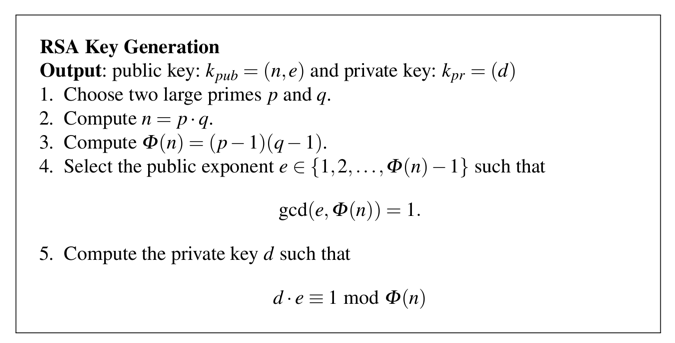
p = 7
q = 23
In addition to p and q, we need to choose e. Let's use:
e = 5

Enter this program into a file named rsa.cbl:
IDENTIFICATION DIVISION.
PROGRAM-ID. RSA.
DATA DIVISION.
WORKING-STORAGE SECTION.
01 WS-X PIC 9(36).
01 WS-N PIC 9(36).
01 WS-D PIC 9(36).
01 WS-P PIC 9(36).
01 WS-Q PIC 9(36).
01 WS-P1 PIC 9(36).
01 WS-Q1 PIC 9(36).
01 WS-E PIC 9(36).
01 WS-PHI PIC 9(36).
01 WS-DIV PIC 9(36).
01 WS-REM PIC 9(36).
PROCEDURE DIVISION.
DISPLAY "ENTER P:".
ACCEPT WS-P.
DISPLAY "ENTER Q:".
ACCEPT WS-Q.
DISPLAY "ENTER E:".
ACCEPT WS-E.
MULTIPLY WS-P BY WS-Q GIVING WS-N.
DISPLAY "N = " WS-N
SUBTRACT 1 FROM WS-P GIVING WS-P1.
SUBTRACT 1 FROM WS-Q GIVING WS-Q1.
MULTIPLY WS-P1 BY WS-Q1 GIVING WS-PHI.
DISPLAY "PHI = " WS-PHI.
DIVIDE WS-PHI BY WS-E GIVING WS-DIV REMAINDER WS-REM.
IF WS-REM = 0 THEN
DISPLAY "ERROR: E MUST NOT BE A DIVISOR OF PHI"
STOP RUN.
CALL 'MODINV36' USING WS-E, WS-PHI, WS-D.
DISPLAY 'D = ' WS-D.
STOP RUN.
Compile it with that file, so you can calculate RSA keys, as shown below.
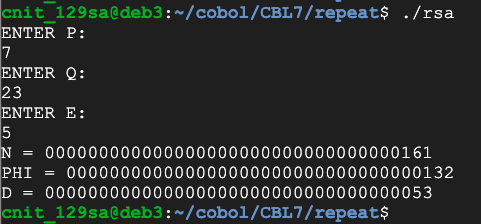
Flag CBL 7.1: Generate D (10 pts)
Calculate d from these values:
AB
65 66

So this program will encrypt a single character with e=5:
IDENTIFICATION DIVISION.
PROGRAM-ID. RSA-EN5.
DATA DIVISION.
WORKING-STORAGE SECTION.
01 WS-X PIC 9(36).
01 WS-N PIC 9(36).
01 WS-Y PIC 9(36).
01 WS-DIV PIC 9(36).
PROCEDURE DIVISION.
DISPLAY 'ENTER X:'.
ACCEPT WS-X.
DISPLAY 'ENTER N:'.
ACCEPT WS-N.
DISPLAY 'USING E = 5'.
MULTIPLY WS-X BY WS-X GIVING WS-Y.
MULTIPLY WS-X BY WS-Y GIVING WS-Y.
MULTIPLY WS-X BY WS-Y GIVING WS-Y.
MULTIPLY WS-X BY WS-Y GIVING WS-Y.
DIVIDE WS-Y BY WS-N GIVING WS-DIV REMAINDER WS-Y.
DISPLAY "Y = " WS-Y.
STOP RUN.

Flag CBL 7.2: Encrypt (10 pts)
Write a progam that encrypts a series of letters, as shown below.
Encrypt the message FLAG in the same manner with this public key:
The result is a 12-digit number. That 12-digit number is the flag.

So this program will decrypt a single character:
IDENTIFICATION DIVISION.
PROGRAM-ID. RSA-DE.
DATA DIVISION.
WORKING-STORAGE SECTION.
01 WS-X PIC 9(36).
01 WS-N PIC 9(36).
01 WS-Y PIC 9(36).
01 WS-D PIC 9(36).
01 WS-I PIC 9(36).
01 WS-DIV PIC 9(36).
PROCEDURE DIVISION.
DISPLAY "ENTER Y:".
ACCEPT WS-Y.
DISPLAY "ENTER D:".
ACCEPT WS-D.
DISPLAY "ENTER N:".
ACCEPT WS-N.
MOVE 1 TO WS-X.
PERFORM VARYING WS-I FROM 1 BY 1 UNTIL WS-I > WS-D
MULTIPLY WS-Y BY WS-X GIVING WS-X
DIVIDE WS-X BY WS-N GIVING WS-DIV REMAINDER WS-X
END-PERFORM.
DISPLAY "X = " WS-X.
STOP RUN.
p = 7
q = 23
e = 5
n = 161
d = 53
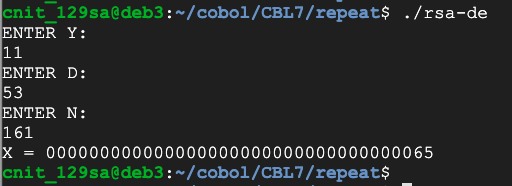
Flag CBL 7.3: Decrypt (10 pts)
Write a progam that decrypts a series of letters, as shown below.
Challenge: use these parameters:
and decrypt this message:
Flag CBL 7.4: Decrypt without the Key (20 pts)
Using this public key:Factor that key and find p, q, and d. Then decode this message. Each number is one encrypted letter.
p = 881
q = 883
e = 13
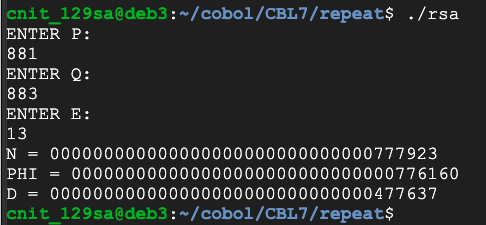
Now use these values:
p = 7349
q = 7351
e = 13
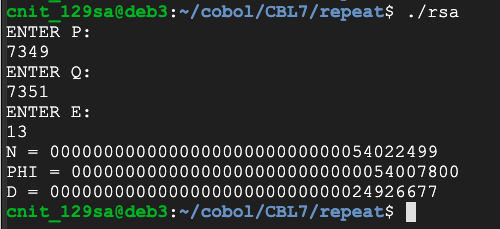
Clearly we can't handle keys much larger than this with the inefficient algorithm we've been using.
Flag CBL 7.5: Euclid's Algorithm (20 pts)
To handle larger keys, we need a faster way to find multiplicative inverses.Write a faster function to calculate d using Euclid's Algorithm. Change all variables to PIC 9(36), the maximum available in COBOL.
Calculate d from these values:
The result is the flag, covered by a green rectangle in the image below.
y = 198174
d = 477637
n = 777923
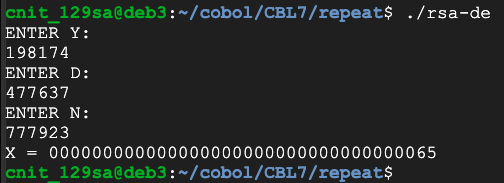
Now use these values:
y = 32179356
d = 24926677
n = 54022499
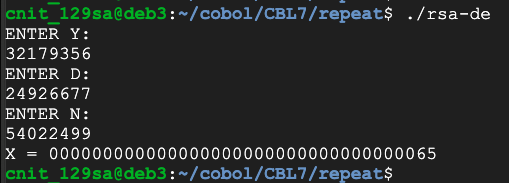
Clearly we can't handle keys much larger than this with the inefficient algorithm we've been using.
Flag CBL 7.6: Modular Exponentiation (20 pts)
To handle larger keys, we need a faster way to raise numbers to high powers.Write a faster function using modular exponentiation.
Calculate x from this function:
with these values:
The result is the flag, covered by a green rectangle in the image below.
Flag CBL 7.7: Finding Large Primes (20 pts)
Fermat's little theorem states that if p is prime and a is not divisible by p, then:
So testing that condition for several random values of a can be used as evidence that p is probably prime. This page explains the Fermat primality test and its flaws in more detail.
Find the first prime number larger than this value:
The result is the flag, covered by a green rectangle in the image below.
Flag CBL 7.8: Factoring a Number (20 pts)
There are faster algorithms, but simply attempting division by every odd number up to the square root of a number is sufficient to find the factors of a number.Find the lower factor of this value:
The result is the flag.
Flag CBL 7.9: Decrypt without the Key (40 pts)
Using this public key:Factor that key and find p, q, and d. Then decode this message.The number 656667 encodes the message ABC
The message is the flag.
Posted 4-13-2020 by Sam Bowne